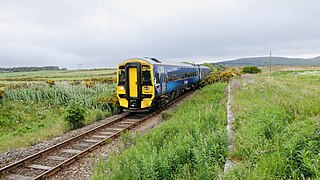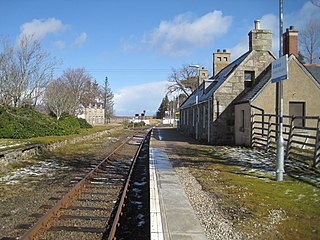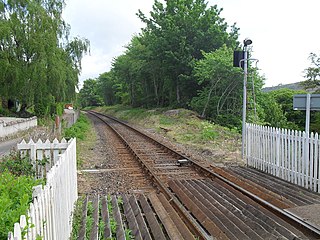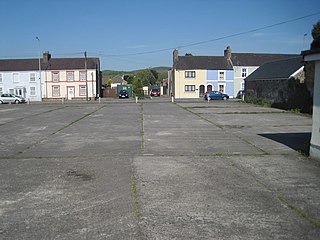Related Research Articles

Helmsdale is a village on the east coast of Sutherland, in the Highland council area of Scotland. The modern village was planned in 1814 to resettle communities that had been removed from the surrounding straths as part of the Highland Clearances.

The Highland Railway (HR) was one of the smaller British railways before the Railways Act 1921, operating north of Perth railway station in Scotland and serving the farthest north of Britain. Based in Inverness, the company was formed by merger in 1865, absorbing over 249 miles (401 km) of line. It continued to expand, reaching Wick and Thurso in the north and Kyle of Lochalsh in the west, eventually serving the counties of Caithness, Sutherland, Ross & Cromarty, Inverness, Perth, Nairn, Moray and Banff. Southward it connected with the Caledonian Railway at Stanley Junction, north of Perth, and eastward with the Great North of Scotland Railway at Boat of Garten, Elgin, Keith and Portessie.

The Far North Line is a rural railway line entirely within the Highland area of Scotland, extending from Inverness to Thurso and Wick. As the name suggests, it is the northernmost railway in the United Kingdom. The line is entirely single-track, with only passing loops at some intermediate stations allowing trains to pass each other. In common with other railway lines in the Highlands and northern Lowlands, it is not electrified and all trains are diesel-powered.

Altnabreac railway station is a rural railway station in the Highland council area of Scotland. It serves the area of Altnabreac – a settlement in which the station itself is the main component – in the historic county of Caithness.

Golspie railway station is a railway station serving the village of Golspie in the Highland council area of Scotland. It is on the Far North Line, situated between Rogart and Dunrobin Castle, 84 miles 30 chains (135.8 km) from Inverness. ScotRail, who manage the station, operate all services.

Brora railway station is a railway station serving the small town of Brora in the Highland council area of Scotland. The station is on the Far North Line, 90 miles 48 chains (145.8 km) from Inverness, between Dunrobin Castle and Helmsdale. ScotRail, who manage the station, operate all services.

Helmsdale railway station is a railway station serving the village of Helmsdale in the Highland council area, northern Scotland. It is located on the Far North Line, between Brora and Kildonan, 101 miles 40 chains (163.3 km) from Inverness. ScotRail, who manage the station, operate all services.

Kinbrace railway station is a railway station serving the village of Kinbrace in the Highland council area in the north of Scotland. It is located on the Far North Line, 118 miles 20 chains from Inverness, between Kildonan and Forsinard. The station is managed by ScotRail, who operate the services at the station.

Forsinard railway station is a railway station serving the village of Forsinard in the Highland council area in the north of Scotland. It is located on the Far North Line, 125 miles 69 chains from Inverness, between Kinbrace and Altnabreac. The station is managed by ScotRail, who operate the services at the station.

Scotscalder railway station is a railway station located in the Highland council area in the far north of Scotland. It serves several rural hamlets in the historic county of Caithness, including Scotscalder, Olgrinmore, Westerdale and Calder. It is accessed from the B870 road, two miles south of Scotscalder Hall.

Georgemas Junction railway station is a railway station located in the Highland council area in the far north of Scotland. It serves several rural hamlets in the historic county of Caithness, including Georgemas, Roadside and Banniskirk. It is also the nearest station to the village of Halkirk, which lies approximately 1.6 miles (2.6 km) west of the station.

Thurso railway station is a railway station located in Thurso, in the Highland council area in the far north of Scotland. It serves the town of Thurso and its surrounding areas in the historic county of Caithness. It is also the nearest station to the port of Scrabster, which has ferry services linking the mainland with Stromness on the Orkney Islands. It is the northernmost station on the National Rail network.
The Sutherland and Caithness Railway was a Scottish railway company that built a line from Helmsdale, the terminus of the Duke of Sutherland's Railway to Wick and Thurso in Caithness, giving the northern towns access to Inverness. It was driven through by the efforts of the 3rd Duke of Sutherland and the engineer Joseph Mitchell in the face of apathy from interests in Wick.
The Sutherland Railway was a railway company authorised in 1865 to build a line from Bonar Bridge station to Brora, a distance of nearly 33 miles, in the north of Scotland. This was to be continuation of a route from Inverness to Bonar Bridge that had been built by the Inverness and Ross-shire Railway; ultimately the line was extended to Thurso.
The Duke of Sutherland's Railway was a railway in Sutherland, Scotland, built by the 3rd Duke of Sutherland.

The Dornoch Light Railway was a branch railway in Scotland that ran from The Mound on the Far North Line to Dornoch, the county town of Sutherland.

Achterneed railway station was a railway station serving Strathpeffer and located on the Kyle of Lochalsh Line, in Wester Ross, Scotland.

Waddesdon Road railway station, called Waddesdon railway station before 1922, was a small halt in open countryside in Buckinghamshire, England. It was opened in 1871 as part of a short horse-drawn tramway to assist with the transport of goods from and around the Duke of Buckingham's extensive estates in Buckinghamshire and to connect the Duke's estates to the Aylesbury and Buckingham Railway at Quainton Road. In 1872 the line was expanded and converted for passenger use, becoming known as the Brill Tramway. In 1899 the operation of the line was taken over by the London-based Metropolitan Railway.
The Far North Line was built in several stages through sparsely populated and undulating terrain. Extending to 161 miles (259 km), it runs north from Inverness to Wick and Thurso in Caithness, and currently carries a regular passenger train service.

Llandilo Bridge railway station served the town of Llandeilo, in the historical county of Carmarthenshire, Wales, from 1865 to 1963 on the Llanelly Railway.
References
- ↑ Quick, M E (2002). Railway passenger stations in England, Scotland and Wales - a chronology. Richmond: Railway and Canal Historical Society. p. 448. OCLC 931112387.
- ↑ Butt, R. V. J. (October 1995). The Directory of Railway Stations: details every public and private passenger station, halt, platform and stopping place, past and present (1st ed.). Sparkford: Patrick Stephens Ltd. p. 245. ISBN 978-1-85260-508-7. OCLC 60251199. OL 11956311M.
| Preceding station | Historical railways | Following station | ||
|---|---|---|---|---|
| Terminus | Duke of Sutherland's Railway | Dunrobin Castle Line and station open | ||